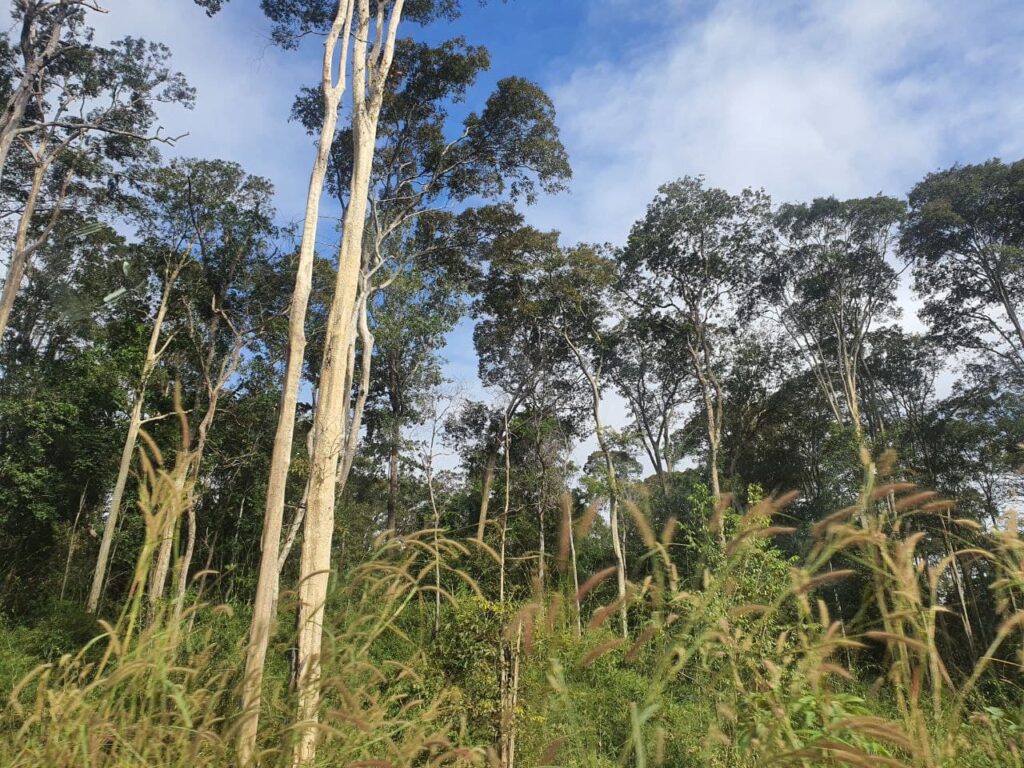
ស្ថានភាពព្រៃឈើ។ រូបភាព អង្គការទិន្នន័យអំពីការអភិវឌ្ឍ ថតនៅថ្ងៃទី ០៥ ខែធ្នូ ឆ្នាំ២០២១។ ក្រោមអាជ្ញាបណ្ណ CC BY-SA 4.0។
ប្រទេសកម្ពុជាគ្របដណ្តប់ដោយព្រៃឈើដែលមានចំនួនប្រហែល ១៣,១ លានហិកតា ក្នុងឆ្នាំ១៩៧៣ ហើយវាបានធ្លាក់ចុះមកនៅត្រឹម ៨,៧ លានហិកតាក្នុងឆ្នាំ២០១៤។1 យោងទៅតាមក្រសួងបរិស្ថាន ព្រៃឈើបានគ្របដណ្តប់ ៧៣% នៃផ្ទៃដីសរុបក្នុងឆ្នាំ១៩៦៥ ហើយថយចុះមកត្រឹម ៤៦,៨៦% នៃផ្ទៃដីសរុបរបស់ប្រទេសក្នុងឆ្នាំ២០១៨។2 ដោយសារការពង្រីកកសិកម្មទ្រង់ទ្រាយធំ និងការកាប់ឈើខុសច្បាប់នៅតែជាបញ្ហាប្រឈមដ៏សំខាន់ ប្រទេសកម្ពុជាកំពុងពិចារណាពីរបៀបតភ្ជាប់ការអភិវឌ្ឍន៍ជាតិ ជាមួយនឹងការគ្រប់គ្រងប្រកបដោយនិរន្តរភាពនៃធនធានព្រៃឈើទាំងនេះ។
សេវាកម្មអេកូឡូស៊ី
សេវាប្រព័ន្ធអេកូឡូស៊ីដើរតួនាទីយ៉ាងសំខាន់ក្នុងការកាត់បន្ថយហានិភ័យគ្រោះមហន្តរាយ តាមរយៈការធានាសន្តិសុខស្បៀង ការផ្តល់ជីវភាពរស់នៅល្អ កាត់បន្ថយគ្រោះថ្នាក់ធម្មជាតិ ការគ្រប់គ្រងសំណឹក ការបន្សុទ្ធទឹក ការបង្កើតដី វដ្តនៃសារធាតុចិញ្ចឹម និងការលើកកម្ពស់សេវាកម្មវប្បធម៌។3
សេវាកម្មប្រព័ន្ធអេកូឡូស៊ីមានដូចខាងក្រោម៖4
- ផលិតផលព្រៃឈើមិនមែនឈើ៖ ការចិញ្ចឹមជីវិត និងប្រាក់ចំណូលជាសាច់ប្រាក់ត្រូវបានប្រើប្រាស់ដើម្បីកាត់បន្ថយភាពក្រីក្រ និងភាពងាយរងគ្រោះ។
- កាបូនស្តុក៖ កាត់បន្ថយកាបូនពីបរិយាកាស និងគ្រប់គ្រងអាកាសធាតុ។
- ទិន្នផលទឹក៖ ការផ្គត់ផ្គង់ទឹកដល់មនុស្ស និងសត្វព្រៃ កាត់បន្ថយការខ្វះខាតទឹកក្នុងអំឡុងពេលគ្រោះរាំងស្ងួត និងព្រឹត្តិការណ៍អាកាសធាតុធ្ងន់ធ្ងរ។
- គុណភាពទីជម្រក៖ ការរក្សាមុខងារអេកូឡូស៊ី ធានាខ្សែអាហារ និងការកំសាន្ត។
- ការរក្សាសារធាតុចិញ្ចឹម និងដីល្បាប់៖ រក្សាដីមានជីជាតិសម្រាប់ដំណាំដាំដុះ ការពារការហូរច្រោះដីពីខ្យល់ ភ្លៀង និងទឹកហូរ។
ការជួញដូរកាបូន
ឥណទានកាបូនត្រូវបានជួញដូរក្រោមក្របខណ្ឌកម្មវិធីជាតិកាត់បន្ថយការបំភាយឧស្ម័នផ្ទះកញ្ចក់ពីការបាត់បង់និងរេចរឹលព្រៃឈើ (រេដបូក) ដែលអនុញ្ញាតឱ្យប្រទេសកំពុងអភិវឌ្ឍន៍ដែលមានព្រៃឈើបង្កើតសាច់ប្រាក់ដោយអនុញ្ញាតឱ្យក្រុមហ៊ុនជៀសវាងការកម្រិតការបំពុលរបស់រដ្ឋាភិបាល។ ប្រទេសកម្ពុជាបានគាំទ្រយ៉ាងខ្លាំងចំពោះការអនុម័តកម្មវិធីរេដបូក ដែលជាគំនិតផ្តួចផ្តើមគោលនយោបាយសកល ដើម្បីកាត់បន្ថយការបំភាយពីការកាប់បំផ្លាញព្រៃឈើ និងការរិចរិលព្រៃឈើ នៅក្នុងសន្និសីទក្របខ័ណ្ឌអង្គការសហប្រជាជាតិស្តីពីការប្រែប្រួលអាកាសធាតុ (UNFCCC) នៃភាគី (COP) នៅកោះបាលីក្នុងឆ្នាំ២០០៧ ក៏ដូចជាតួនាទីនៃការគ្រប់គ្រងព្រៃឈើប្រកបដោយនិរន្តរភាព ការអភិរក្ស និងការលើកកម្ពស់កាបូនស្តុកក្នុងប្រទេសកំពុងអភិវឌ្ឍន៍។ ក្នុងអំឡុងឆ្នាំ ២០០៨-២០១៦ កម្មវិធីរេដបូកកម្ពុជា បានឈានដល់ចំណុចសំខាន់ និងបានរៀនមេរៀនសំខាន់ៗជាច្រើនៗ។ រាជរដ្ឋាភិបាលបានកំណត់រេដបូក ជាមធ្យោបាយមួយសម្រាប់កម្ពុជាក្នុងការរួមចំណែកក្នុងការដោះស្រាយការប្រែប្រួលអាកាសធាតុជាសាកល និងបំពេញតាមការប្តេជ្ញាចិត្តរបស់ UNFCCC។5
រេដបូកផ្តល់ឱ្យរដ្ឋាភិបាលនូវឱកាសដ៏សំខាន់មួយក្នុងការកែលម្អវិធីសាស្ត្រធ្វើសេចក្តីសម្រេចចិត្ត និងការចូលរួមពីភាគីពាក់ព័ន្ធ ពង្រឹងការអនុវត្តច្បាប់ និងការចែកចាយអត្ថប្រយោជន៍ និងការប្រយុទ្ធប្រឆាំងអំពើពុករលួយនិងអត្ថប្រយោជន៍ខុសច្បាប់។6 រដ្ឋាភិបាលបានបង្កើតកម្មវិធីរេដបូក នៅខេត្តកោះកុង មណ្ឌលគិរី ក្រចេះ កំពង់ធំ ស្ទឹងត្រែង និងឧត្តរមានជ័យ7 ដូចដែលបានឃើញនៅក្នុងប្រព័ន្ធត្រួតពិនិត្យព្រៃឈើជាតិកម្ពុជា។
ក្របខណ្ឌច្បាប់ និងគោលនយោបាយរេដបូក
ក្របខណ្ឌច្បាប់ និងគោលនយោបាយមួយចំនួនគាំទ្រដល់ការអនុវត្តរេដបូកនៅកម្ពុជារួមមាន៖
- រដ្ឋធម្មនុញ្ញតនៃព្រះរាជាណាចក្រកម្ពុជា ១៩៩៣
- គោលការណ៍សំខាន់ៗ
- ច្បាប់សំខាន់ៗ និងក្របខ័ណ្ឌច្បាប់
- ច្បាប់ភូមិបាល (២០០១)
- ច្បាប់គ្រប់គ្រងដីរដ្ឋនៅកម្ពុជា
- អនុក្រឹត្យស្តីពីវិធាន និងនីតិវិធីសម្រាប់ការចាត់ថ្នាក់ឡើងវិញនូវទ្រព្យសម្បត្តិរដ្ឋ និងនីតិបុគ្គលសាធារណៈ
- ច្បាប់ស្តីពីព្រៃឈើ ២០០២
- អនុក្រឹត្យលេខ ៧៩ ស្តីពីការគ្រប់គ្រងសហគមន៍ព្រៃឈើ
- ច្បាប់ស្តីពីតំបន់ការពារធម្មជាតិ (២០០៨)
- ច្បាប់ការពារបរិស្ថាន និងការគ្រប់គ្រងធនធានជាតិ (១៩៩៦)
- ច្បាប់ជលផល (២០០៦)
- ច្បាប់ស្តីពីការគ្រប់គ្រង និងការធ្វើអាជីវកម្មធនធានរ៉ែ (២០០១)
- ច្បាប់វិនិយោគ (១៩៩៤)
- ច្បាប់ស្តីពីការប្តូរប្រាក់បរទេស (១៩៩៧)
- ច្បាប់ស្តីពីការអនុវត្តក្រមរដ្ឋប្បវេណី (២០១១)។
យុទ្ធសាស្ត្រជាតិរេដបូក (NRS) ឆ្នាំ២០១៧-២០២៦
យុទ្ធសាស្ត្រជាតិរេដបូកនឹងបង្រួបបង្រួម និងបំពេញការត្រៀមខ្លួនរបស់ខ្លួន បង្កើតរចនាសម្ព័ន្ធស្ថាប័ន ទទួលហិរញ្ញប្បទានសមស្រប និងអនុវត្តសកម្មភាពដែលនឹងរួមចំណែកដល់ការកាត់បន្ថយកាបូន និងធ្វើឱ្យប្រទេសកម្ពុជាមានសិទ្ធិទទួលបានការទូទាត់ផ្អែកលើលទ្ធផល។ យុទ្ធសាស្ត្រជាតិរេដបូកចែកចេញជាពីរដំណាក់កាលដូចខាងក្រោម៖
- ដំណាក់កាលទី១៖ រចនាសម្ព័ន្ធវិចារណញាណ ការវាយតម្លៃនៃការអនុវត្តយុទ្ធសាស្ត្រជាតិរេដបូក សេចក្តីសង្ខេបនៃការកៀរគរថវិកាផ្អែកលើលទ្ធផល និងការផ្លាស់ប្តូរទៅដំណាក់កាលអនុវត្ត។
- ដំណាក់កាលទី២៖ បញ្ចប់ការផ្លាស់ប្តូរពីការត្រៀមខ្លួនទៅជាការអនុវត្ត ដោយផ្តោតលើការសម្រេចបាននូវលទ្ធផលជាបរិមាណ។
ការបំភាយនិងព្រៃឈើដែលដកចេញឧស្ម័នផ្ទះកញ្ចក់
យោងតាមការវាយតម្លៃរបស់កម្ពុជា ការបំភាយឧស្ម័នផ្ទះកញ្ចក់ប្រចាំឆ្នាំពីការកាប់បំផ្លាញព្រៃឈើមានចំនួន ៣៤.១៤៨.៦២៩ tCO2 ពីឆ្នាំ២០០៦ ដល់ឆ្នាំ២០១០ និង ១៥១.២៦៧.៥២៨ tCO2 ពីឆ្នាំ២០១០ ដល់ ២០១៤ មានន័យថាកើនឡើងបួនដង។ តំបន់ព្រៃឈើដែលនៅសេសសល់ក្នុងប្រទេសកម្ពុជា ដើរតួជាស្នូកកាបូន។ ពីឆ្នាំ២០០៦ ដល់ឆ្នាំ២០១០ ឧស្ម័នផ្ទះកញ្ចក់របស់កម្ពុជាដែលដកចេញពីព្រៃឈើមានចំនួនជាមធ្យមប្រចាំឆ្នាំ -៦.៦២៦.០៤៦ tCO2 និង -២០.២៩៨.៨២៥ tCO2 ពីឆ្នាំ២០១០ ដល់ឆ្នាំ២០១៤។ ជាលទ្ធផល ធាតុចូលឧស្ម័នផ្ទះកញ្ចក់សរុបពីការកាប់បំផ្លាញព្រៃឈើ និងត្រូវបានដកចេញ ១៥៨.៤៩១.២៨៦ tCO2។ វាត្រូវគ្នាទៅនឹងមធ្យមប្រចាំឆ្នាំ ៧៩.២៤៥.៦៤៣ tCO2។8
នៅខែធ្នូ ឆ្នាំ២០២១ ក្រុមប្រឹក្សាជាតិអភិវឌ្ឍន៍ដោយចីរភាព (NCSD) និងក្រសួងបរិស្ថានបានចេញផ្សាយរបាយការណ៍ផ្លូវការមួយដែលមានចំណងជើងថា “យុទ្ធសាស្ត្ររយៈពេលវែងរបស់កម្ពុជាសម្រាប់អព្យាក្រឹតភាពកាបូន (LTS4CN)” ។ រៀងរាល់ប្រាំឆ្នាំ LTS4CN នឹងត្រូវបានវាយតម្លៃ។ យោងតាម LTS4CN ប្រទេសកម្ពុជាអាចឈានដល់អព្យាក្រឹតភាពនៃកាបូននៅឆ្នាំ២០៥០ ជាមួយនឹងវិស័យព្រៃឈើ និងការប្រើប្រាស់ដីផ្សេងទៀត (FOLU) ដែលផលិតបរិមាណកាបូនសរុប ៥០ មេហ្គាតោននៃសមមូល CO2 (MtCO2e)។ ឧស្សាហកម្មថាមពលត្រូវបានព្យាករណ៍ថាជាអ្នកបញ្ចេញឧស្ម័ន CO2e ដ៏ធំបំផុតនៅឆ្នាំ២០៥០ ដែលមាន ២៨ MtCO2e បន្ទាប់មកកសិកម្មមាន ១៩ MtCO2e ។ ឧស្សាហកម្មកាកសំណល់ និងដំណើរការឧស្សាហកម្ម និងការប្រើប្រាស់ផលិតផល (IPPU) ត្រូវបានអនុញ្ញាតឱ្យបញ្ចេញ CO2e ចំនួន ១,៦ និង ១,២ លានតោនរៀងៗគ្នា។9
នៅឆ្នាំ២០៣០ ការបាត់បង់ព្រៃឈើ និងការប្រើប្រាស់ដីផ្សេងទៀតនឹងមានចំនួន ៤៩% នៃការបំភាយឧស្ម័នផ្ទះកញ្ចក់ប្រចាំឆ្នាំរបស់ប្រទេសកម្ពុជា បន្ទាប់មកដោយវិស័យថាមពល ២២% និងកសិកម្ម ១៧,៥%។10
គម្រោងរេដបូកនៅកម្ពុជា
ប្រទេសកម្ពុជាមានតំបន់ការពារចំនួន ៧,៣ លានហិកតា ឬប្រហែល ៤១% នៃប្រទេស។11 ពីឆ្នាំ២០១៦ ដល់ ២០២០ កម្ពុជារកចំណូលបាន ១១,៦ លានដុល្លារពីការលក់ឥណទានកាបូននៅក្នុងដែនជម្រកសត្វព្រៃកែវសីមា ខេត្តមណ្ឌលគិរី និងគម្រោងរេដបូក នៅឧទ្យានជាតិក្រវាញខាងត្បូងក្នុងខេត្តកោះកុង។12
ផែនទីតំបន់ការពារធម្មជាតិក្នុងប្រទេសកម្ពុជា (១៩៩៣ - ២០២៣)
គម្រោងរេដបូកដែលបានដំណើរការគឺ គម្រោងរេដបូក Tumring ដែនជម្រកសត្វព្រៃកែវសីមា គម្រោងឧទ្យានជាតិក្រវាញខាងត្បូង គម្រោងរេដបូកឧត្តមានជ័យ និងគម្រោងរេដបូកដែនជម្រកសត្វព្រៃព្រៃឡង់ ខណៈដែលគម្រោងមួយទៀតស្ថិតនៅក្នុងការរងចាំ (Cambodia National Animal)។ ចាប់ពីឆ្នាំ២០១៣ ដល់ឆ្នាំ២០១៧ ការកាត់បន្ថយការបំភាយឧស្ម័នដែលបានផ្ទៀងផ្ទាត់គឺ ២០.៣៣៦.៤៦២ លាន tCO2e។13
- គម្រោងរេដបូប Tumring ៖ គ្របដណ្តប់លើផ្ទៃដីប្រហែល ៦៦.៦៤៥ ហិកតា នៅភាគកណ្តាលប្រទេសកម្ពុជា ភាគខាងលិចនៃទន្លេមេគង្គ ហើយមានទីតាំងនៅភាគនិរតីនៃដែនជម្រកសត្វព្រៃឡង់ដែលទើបនឹងប្រកាសថ្មីៗនេះ។14 គម្រោងនេះនឹងនាំឱ្យមានការកាត់បន្ថយការបំភាយឧស្ម័នចំនួន ៣,៩ លាន tCO2e ក្នុងរយៈពេល ១០ឆ្នាំ។15
- ដែនជម្រកសត្វព្រៃកែវសីមា៖ មានទំហំ ២៩២.៦៩០ ហិកតា។ វាមានទីតាំងនៅភាគខាងកើតនៃប្រទេសកម្ពុជា ជាចម្បងនៅក្នុងខេត្តមណ្ឌលគិរី ដែលមានផ្នែកតូចមួយលាតសន្ធឹងទៅខេត្តក្រចេះ។ តំបន់គម្រោងរេដបូកគ្របដណ្តប់លើផ្ទៃដី ១៦៦.៩៨៣ ហិកតានៃព្រៃឈើនៅក្នុងតំបន់ការពារស្នូលដែនជម្រកសត្វព្រៃកែវសីមា។16 ដែនជម្រកសត្វព្រៃកែវសីមាផ្ទុកឧស្ម័ន CO2e ជាង ៧៥លានតោន។17
- គម្រោងរេដបូកក្រវាញខាងត្បូង៖ លើផ្ទៃដី ៤៤៥.៣៣៩ ហិកតា រួមមានផ្នែកនៃឧទ្យានជាតិក្រវាញខាងត្បូង និងដែនជម្រកសត្វព្រៃតាតៃ ហើយវានឹងអភិរក្សផ្នែកសំខាន់មួយនៃតំបន់ព្រៃភ្នំក្រវាញ ដែលជាតំបន់មួយក្នុងចំណោមតំបន់ ២០០ ដ៏សំខាន់បំផុតរបស់ពិភពលោកសម្រាប់តំបន់ការពារជីវចម្រុះ។ អត្ថប្រយោជន៍អាកាសធាតុរបស់គម្រោងរួមមាន ការជៀសវាងការបំភាយឧស្ម័នប្រហែល ១២លាន tCO2e ក្នុងអំឡុងពេលត្រួតពិនិត្យដំបូង និងការបំភាយឧស្ម័ន ជាង ១១៥.០០០ លាន tCO2e ក្នុងអំឡុងពេលអាយុកាលរបស់គម្រោង។18 គម្រោងនេះការពារការបញ្ចេញកាបូនច្រើនជាង ៣ លានតោនក្នុងមួយឆ្នាំ។19
- គម្រោងរេដបូកឧត្តមានជ័យ៖ គម្រោងគ្របដណ្តប់លើផ្ទៃដីប្រមាណ ៦៣.៨៣១ ហិកតានៃព្រៃស្រោង និងព្រៃល្បោះដែលលាតសន្ធឹងនៅភាគពាយ័ព្យ នៃប្រទេសកម្ពុជា។ គម្រោងនេះនឹងបង្កើតបានចំនួន ៨,២ លានតោននៃការកាត់បន្ថយការបំភាយដោយបានផ្ទៀងផ្ទាត់ (VCRs) ក្នុងរយៈពេល ៣០ ឆ្នាំ។ 20
- គម្រោងរេដបូកដែនជម្រកសត្វព្រៃព្រៃឡង់៖ គម្រោងនេះមានផ្ទៃដីប្រមាណ ៤៣១.៦៨៣ ហិកតា ដែលគ្របដណ្តប់ខេត្តចំនួនបួនគឺខេត្តក្រចេះ កំពង់ធំ ស្ទឹងត្រែង និងខេត្តព្រះវិហារ។ គម្រោងនេះអាចកាត់បន្ថយការបំភាយឧស្ម័ន ប្រមាណ ៤.២៣១.១០៩,២ tCO2e ។ 21
ទាក់ទងនឹងការជួញដូរកាបូន និងការចំណាយប្រាក់ដទៃទៀត ដើម្បីទទួលបានសេវាកម្មអេកូឡូហ្សី៖
- ការការពារបរិស្ថាន និងជីវៈចម្រុះ
- ការប្រែប្រួលអាកាសធាតុ
- ព្រៃឈើ និងរុក្ខាប្រមាញ់
- គោលនយោបាយ និងការគ្រប់គ្រងបរិស្ថាន និងធនធានធម្មជាតិ
- បរិស្ថាន និងធនធានធម្មជាតិ
ឯកសារយោង
- 1. អង្គការទិន្នន័យអំពីការអភិវឌ្ឍ, “គម្របព្រៃឈើ,” ឆ្នាំ២០១៥, បានចូលអាននៅថ្ងៃទី ០៤ ខែមីនា ឆ្នាំ២០២២។
- 2. ក្រសួងបរិស្ថាន, “របាយការណ៍ស្ថានភាពបរិស្ថានលើកទី៤,” ឆ្នាំ២០២១, បានចូលអាននៅថ្ងៃទី ១៤ ខែកុម្ភៈ ឆ្នាំ២០២២។
- 3. អង្គការស្បៀងអាហារ និងកសិកម្ម, “ការវាយតម្លៃធនធានព្រៃឈើជាសកលឆ្នាំ២០១៥៖ តើព្រៃឈើនៅលើពិភពលោកមានការផ្លាស់ប្តូរយ៉ាងដូចម្តេច?,” ការបោះពុម្ពលើកទី២, ឆ្នាំ២០១៦, បានចូលអាននៅថ្ងៃទី ២៤ ខែកុម្ភៈ ឆ្នាំ២០២២។
- 4. Watkins, et al., “ការធ្វើផែនទី និងការវាយតម្លៃសេវាប្រព័ន្ធអេកូឡូស៊ីក្នុងខេត្តមណ្ឌលគិរី៖ លទ្ធផល និងអនុសាសន៍សម្រាប់ការរៀបចំផែនការប្រើប្រាស់ដីធ្លីប្រកបដោយនិរន្តរភាពនៅប្រទេសកម្ពុជា,” ខែកញ្ញា ឆ្នាំ២០១៦, បានចូលអាននៅថ្ងៃទី ២៤ ខែកុម្ភៈ ឆ្នាំ២០២២។
- 5. “យុទ្ធសាស្ត្រជាតិរេដបូក (NRS) ឆ្នាំ២០១៧-២០២៦,” ថ្ងៃទី ០៨ ខែធ្នូ ឆ្នាំ២០១៧, បានចូលអាននៅថ្ងៃទី ០៩ ខែកុម្ភៈ ឆ្នាំ២០២២។
- 6. អង្គការស្បៀងអាហារ និងកសិកម្ម, “អភិបាលកិច្ចព្រៃឈើ និងច្បាប់ព្រៃឈើសម្រាប់រេដបូក,” បានចូលអាននៅថ្ងៃទី ១០ ខែកុម្ភៈ ឆ្នាំ២០២២។
- 7. រេដបូកកម្ពុជា, “ប្រព័ន្ធត្រួតពិនិត្យព្រៃឈើជាតិកម្ពុជា,” បានចូលអាននៅថ្ងៃទី ០៩ ខែកុម្ភៈ ឆ្នាំ២០២២។
- 8. “យុទ្ធសាស្ត្រជាតិរេដបូក (NRS) ឆ្នាំ២០១៧-២០២៦,” ថ្ងៃទី ០៨ ខែធ្នូ ឆ្នាំ២០១៧, បានចូលអាននៅថ្ងៃទី ០៩ ខែកុម្ភៈ ឆ្នាំ២០២២។
- 9. ក្រុមប្រឹក្សាជាតិអភិវឌ្ឍន៍ដោយចីរភាព, “យុទ្ធសាស្ត្ររយៈពេលវែងរបស់កម្ពុជាសម្រាប់អព្យាក្រឹតភាពកាបូន,” ខែធ្នូ ឆ្នាំ២០២១, បានចូលអាននៅថ្ងៃទី ១០ ខែកុម្ភៈ ឆ្នាំ២០២២។
- 10. Sunniya Durrani-Jamal និង Darren Byers, “កម្ពុជាកំពុងបោះជំហានទៅមុខលើផ្លូវដ៏វែងឆ្ពោះទៅរកកំណើនសេដ្ឋកិច្ចកាបូនទាប," ប្លុកអភិវឌ្ឍន៍អាស៊ី, ថ្ងៃទី ២៥ ខែសីហា ឆ្នាំ២០២១, បានចូលអាននៅថ្ងៃទី ១០ ខែកុម្ភៈ ឆ្នាំ២០២២។
- 11. សុន មិនា, "នៅលើផ្លូវត្រូវដើម្បីបង្កើតឥណទានកាបូន," ខ្មែរថាមស៍, ថ្ងៃទី ២៣ ខែសីហា ឆ្នាំ២០២១, បានចូលអាននៅថ្ងៃទី ១០ ខែកុម្ភៈ ឆ្នាំ២០២២។
- 12. អោប ប៊ុនធឿន, "ឥណទានកាបូនផ្តល់មូលនិធិដល់ព្រៃឈើ," ភ្នំពេញប៉ុស្តិ៍, ថ្ងៃទី០៨ ខែកុម្ភៈ ឆ្នាំ២០២២, បានចូលអាននៅថ្ងៃទី ០៩ ខែកុម្ភៈ ឆ្នាំ២០២២។
- 13. រេដបូកកម្ពុជា, "ទិន្នន័យគម្រោងរេដបូកជាតិរបស់កម្ពុជា," បានចូលអាននៅថ្ងៃទី ០៩ ខែកុម្ភៈ ឆ្នាំ២០២២។
- 14. ដូចឯកសារយោងខាងដើម។
- 15. សេវាកម្មព្រៃឈើកូរ៉េ, "គម្រោង Tumring REDD+," បានចូលអាននៅថ្ងៃទី ១០ ខែកុម្ភៈ ឆ្នាំ២០២២។
- 16. រេដបូកកម្ពុជា, "ទិន្នន័យគម្រោងរេដបូកជាតិរបស់កម្ពុជា," បានចូលអាននៅថ្ងៃទី ០៩ ខែកុម្ភៈ ឆ្នាំ២០២២។
- 17. អង្គការសមាគមអភិរក្សសត្វព្រៃ, "ដែនជម្រកសត្វព្រៃកែវសីមា," បានចូលអាននៅថ្ងៃទី ១០ ខែកុម្ភៈ ឆ្នាំ២០២២។
- 18. រេដបូកកម្ពុជា, "ទិន្នន័យគម្រោងរេដបូកជាតិរបស់កម្ពុជា," បានចូលអាននៅថ្ងៃទី ០៩ ខែកុម្ភៈ ឆ្នាំ២០២២។
- 19. អង្គការសម្ព័ន្ធមិត្តសត្វព្រៃ, "គម្រោងរេដបូក," បានចូលអាននៅថ្ងៃទី ១០ ខែកុម្ភៈ ឆ្នាំ២០២២។
- 20. Terra Global Capital, "គម្រោងរេដបូកសហគមន៍ឧត្តរមានជ័យ ប្រទេសកម្ពុជា," បានចូលអាននៅថ្ងៃទី ០៣ ខែកុម្ភៈ ឆ្នាំ២០២៣។
- 21. JMC "ដែនជម្រកសត្វព្រៃព្រៃឡង់ - គម្រោងរេដបូក ស្ទឹងត្រែង," បានចូលអាននៅថ្ងៃទី ០៣ ខែកុម្ភៈ ឆ្នាំ២០២៣។

